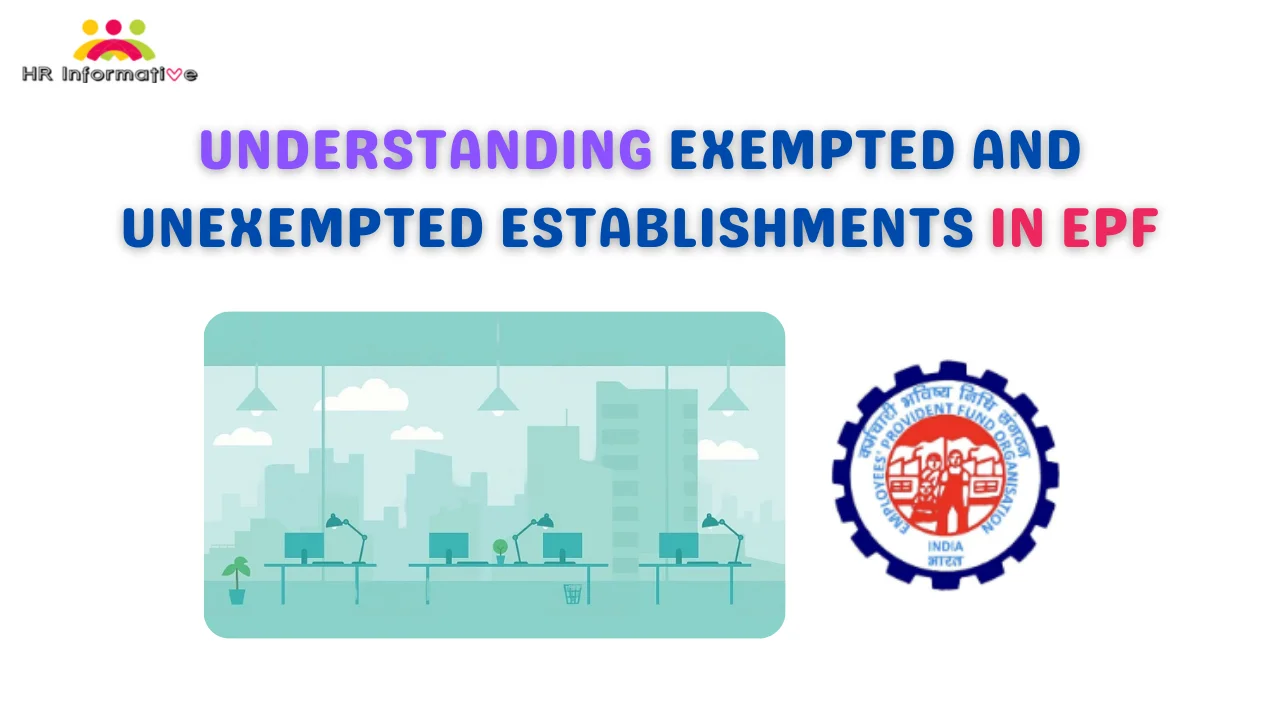Introduction
The Employees’ Provident Fund (EPF) is a social security scheme established by the Government of India to provide financial security and stability to employees across various sectors. The EPF is managed by the Employees’ Provident Fund Organization (EPFO). However, not all establishments fall under the purview of EPF regulations. There are two categories of establishments: exempted and unexempted. This article aims to provide a detailed understanding of these categories, their implications, and the factors determining their classification.
Exempted Establishments
Exempted establishments refer to those organizations that have received approval from the EPFO to manage their own provident fund trusts. Such establishments must meet certain criteria set by the EPFO to obtain exemption.
Key Points About Exempted Establishments
Some key points about exempted establishments include:
a. Trust Management: Exempted establishments establish and manage their own provident fund trusts. These trusts are responsible for administering the provident fund contributions and benefits of their employees.
b. Regulatory Oversight: Although exempted establishments manage their own funds, they are still subject to supervision and monitoring by the EPFO. The EPFO ensures compliance with relevant laws and regulations.
c. Benefits and Contributions: The contribution rates and benefits provided by exempted establishments are generally similar to those of unexempted establishments. The employee’s contribution is deducted from their salary, and the employer contributes an equal amount to the provident fund.
d. Flexibility and Customization: Exempted establishments have more flexibility in designing their provident fund schemes. They can customize certain aspects such as interest rates, withdrawal rules, and other conditions, within the framework provided by the EPFO.
e. Enhanced Services: Exempted establishments often provide additional services to their employees, such as online access to account information, easy withdrawal processes, and efficient grievance redressal systems.
Unexempted Establishments
Unexempted establishments are those organizations that do not have an approved exemption from the EPFO. These establishments must mandatorily comply with the EPF regulations outlined by the EPFO.
Key Aspects of Unexempted Establishments
Some key aspects of unexempted establishments are as follows:
a. EPFO Management: Unexempted establishments are required to register with the EPFO and contribute to the central provident fund managed by the EPFO. The EPFO manages the contributions and administers the benefits to employees.
b. Standardized Regulations: Unexempted establishments follow the EPF Act, which outlines the contribution rates, withdrawal rules, and other provisions applicable to all covered establishments.
c. EPF Services: Employees in unexempted establishments can avail themselves of various EPF services provided by the EPFO, including online access to account details, balance checks, and claims settlements.
d. Compliance and Audits: Unexempted establishments are subject to periodic audits and inspections by EPFO officials to ensure compliance with the regulations. They must adhere to EPFO guidelines regarding contribution remittance, timely filings, and maintaining necessary records.
Factors Affecting Classification
The classification of an establishment as exempted or unexempted depends on several factors, including:
a. Employee Strength: Establishments with a larger workforce are more likely to be unexempted, as obtaining exemption is generally more feasible for smaller organizations.
b. Financial Stability: Financially stable organizations with robust systems for managing employee benefits may have a higher chance of receiving exemption.
c. Administrative Capability: Establishments capable of effectively managing their own provident fund trusts, including record-keeping, fund management, and compliance, are more likely to be considered for exemption.
Conclusion
The distinction between exempted and unexempted establishments in the EPF system is crucial in understanding how different organizations manage their employees’ provident fund contributions. While exempted establishments have the flexibility to design and manage their own funds, unexempted establishments rely on the EPFO for the administration of employee benefits. Regardless of the category, the ultimate goal remains to provide financial security and stability to employees throughout their working lives.
FAQs
Q1: What is the Employees’ Provident Fund (EPF)?
Ans: The Employees’ Provident Fund (EPF) is a social security scheme established by the Government of India to provide financial security and stability to employees across various sectors. It is managed by the Employees’ Provident Fund Organization (EPFO).
Q2: What are exempted establishments in EPF?
Ans: Exempted establishments are organizations that have received approval from the EPFO to manage their own provident fund trusts. They must meet certain criteria set by the EPFO to obtain exemption.
Q3: How do exempted establishments manage their provident fund?
Ans: Exempted establishments establish and manage their own provident fund trusts. These trusts are responsible for administering the provident fund contributions and benefits of their employees.
Q4: Are exempted establishments completely independent from EPFO regulations?
Ans: No, even though exempted establishments manage their own funds, they are still subject to supervision and monitoring by the EPFO. The EPFO ensures compliance with relevant laws and regulations.
Q5: What are unexempted establishments in EPF?
Ans: Unexempted establishments are organizations that do not have an approved exemption from the EPFO. They must mandatorily comply with the EPF regulations outlined by the EPFO.
Q6: How are provident fund contributions managed in unexempted establishments?
Ans: Unexempted establishments are required to register with the EPFO and contribute to the central provident fund managed by the EPFO. The EPFO manages the contributions and administers the benefits to employees.
Q7: Can exempted and unexempted establishments have different contribution rates and benefits?
Ans: Generally, the contribution rates and benefits provided by exempted establishments are similar to those of unexempted establishments. However, exempted establishments have more flexibility in customizing certain aspects within the framework provided by the EPFO.
Q8: What services are available to employees in unexempted establishments?
Ans: Employees in unexempted establishments can avail themselves of various EPF services provided by the EPFO, including online access to account details, balance checks, and claims settlements.
Q9: What are the compliance requirements for unexempted establishments?
Ans: Unexempted establishments are subject to periodic audits and inspections by EPFO officials to ensure compliance with the regulations. They must adhere to EPFO guidelines regarding contribution remittance, timely filings, and maintaining necessary records.
You May Read Also :




